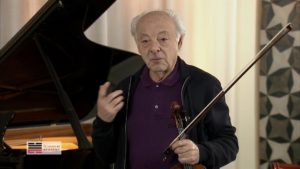MENDELSSOHN VIOLIN CONCERTO IN E MINOR, OP. 64, 1ST MOV
CORNERSTONE LESSON MENDELSSOHN
One of the most frequently performed violin concertos, and also one of the most lyrical and flowing works of its type. The movement contains a variety of thematic expositions, developments, and recapitulation of the themes, all of them examined by Professor Gyorgy Pauk and with the help of young talented Elena Kawazu.

Masterclass recorded in March 2015 ©iClassical Academy.
Don't forget that it's a musical concert, so it's imperative not to get aggressive or rough in the quick passages and, as Maestro Pauk says, "keep singing".
History of the piece
At the beginning of the 20th century, it was universally accepted that German composers had produced four milestones in violin concertos. Beethoven's and Brahms' concertos were competing for the most profound; Bruch's was considered the most seductive, Mendelssohn's was viewed as the most brilliant jewel of the heart.
Yet, only a few know these three particular things about this romantic and virtuoso concerto Mendelssohn composed.
- Why are the 1st and 2nd movements connected? Many wrote that because Mendelssohn hated the habit of audiences applauding between movements, he decided that the 1st and 2nd had to be played without interruptions to prevent the audience from clapping. But it's more likely that he chose to do so because of his determination in developing compositive cycles to the extreme, which we also find in the third movement.
- In this composition, Mendelssohn wanted to innovate the habit of the composers to let the orchestra play for a while and have the violin coming in only after a certain number of bars. Hence, the violin plays already in the second bar!
- Mendelssohn's presence made the difference. The first performance was in 1845 in Leipzig, where Mendelssohn couldn't conduct due to health problems. Six months later, the concert was performed in the same theatre, played by the same violinist (Ferdinand David), but with Mendelssohn on the podium. It was a great success, confirming again how the soul and inner energy guiding any performance always makes the difference.
Articulations of the Octaves and how to get up bow and down bow strokes even, combined with the need to make all the notes very clearly audible.
What to expect in the Masterclass
Following the Masterclass, you will learn how to be aware of how to stay clean in your sound, even during quick passages, how to keep the sound lyrical and "cantabile," and how to organize your bowing when you have to be regular, as well as intense. Then, as any violinist knows, one of the most challenging things to do is to arrive at the finale intense and concentrated enough to render the growth of the atmosphere. Still, it comes precisely in a moment in which you risk being tired and possibly not intense and expressive enough.
Prof. Gyorgy Pauk is one of the greatest Masters of this kind of school, and here you will find precious teachings to achieve this particular skill.
A particular passage with an escalation of intensity, so what's the best way to play it? Sustain your sound and keep a lot of vibratos.
